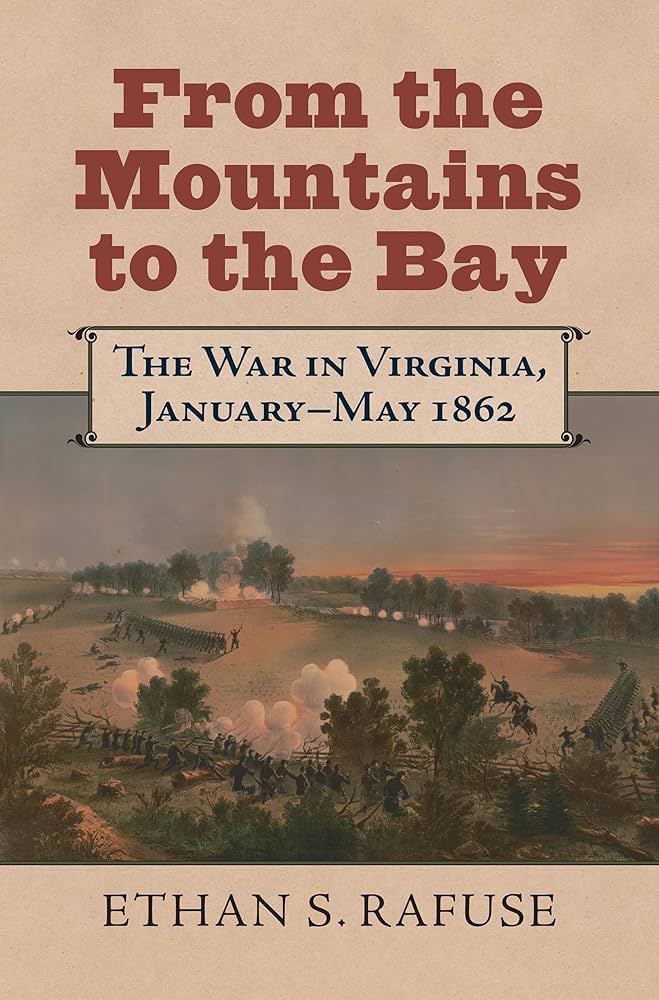Book Review: From the Mountains to the Bay: The War in Virginia, January – May 1862

 From the Mountains to the Bay: The War in Virginia, January – May 1862. By Ethan S. Rafuse. Lawrence, KS: University Press of Kansas, 2023. Hardcover, 400 pp. $54.99.
From the Mountains to the Bay: The War in Virginia, January – May 1862. By Ethan S. Rafuse. Lawrence, KS: University Press of Kansas, 2023. Hardcover, 400 pp. $54.99.
Reviewed by John G. Selby
Ethan Rafuse offers a challenge to Civil War readers: examine several well-studied campaigns from a new perspective. Rafuse is a popular lecturer and a prolific scholar, with eight Civil War books and more published articles than this brief review can list. Rafuse centers his analysis of the war in Virginia on the early months of 1862. In eleven concise chapters he dissects the command decisions and movements of armies in northern Virginia, the Shenandoah Valley, and the Peninsula. Most importantly, by tracking daily developments in each area, Rafuse shows the overarching importance of understanding contingency in history. Many times initial plans were altered by events in the field, which in turn prompted redirection of troops and resources from one area to another. For example, when Confederates abandoned Fredericksburg in late April rather than fight an army five times larger, it freed up General Irvin McDowell to rebuild the railroad in the area and eventually head south to join up with General George McClellan’s army outside of Richmond (though McDowell’s army would ultimately be diverted to the Shenandoah Valley).
Rafuse ably guides the reader through the well-known battles of the period: the Monitor v. the Virginia naval engagement and Kernstown in March; and Williamsburg, Drewry’s Bluff, and McDowell in May. More critically, he looks anew at McClellan’s slow advance up the Peninsula. It is no surprise that one of McClellan’s most astute biographers finds efficacy in “Little Mac’s” steady advance. While many historians have criticized McClellan for exhibiting the “slows,” Rafuse argues that “a number (of men) took comfort from the prudent, methodical way McClellan was conducting the operation.” (182) When the Confederates abandoned their fortifications at Yorktown and retreated after the battle of Williamsburg, McClellan and his generals felt vindicated. Even Congress got in on the act: the House of Representatives adopted a resolution of “thanks” to McClellan after the occupation of Yorktown for the “’display of those high military qualities which secure important results but little sacrifice of human life.’” (226)
Several trends tie the disparate events of this period together. They include: General Jackson’s increasing use of movement initiative to keep his Union opponents off-guard and continually responding to his actions; the tug-of-war between McClellan and Union naval commanders on the best use of the naval forces; the constant frustration of President Lincoln and some members of his cabinet over McClellan’s deliberate style of movement and preference for siege (not to mention his inflation of enemy numbers and repeated demands for more troops); and the strained relationship between President Jefferson Davis and General Joseph Johnston. The nub of the matter was their different views of how the army should be used. Davis wanted a nimble army, striking when least expected. Johnston saw the limitations of his resources and preferred to retreat to well-fortified defenses and only strike when his enemy’s flanks or supply lines appeared vulnerable.
These trendlines converged towards the end of May (when the book ends). Jackson was about to embark on the lightning attacks that would spark fear in Washington and establish his reputation, while McClellan’s massive army was just outside of Richmond, poised to lay siege to the city and perhaps end the war. Meanwhile, Davis fretted over the inactivity of Johnston, and increasingly looked to his “general-in-chief,” Robert E. Lee, for advice and affirmation. When Lincoln and some of the cabinet visited McDowell in Fredericksburg in May, “confidence certainly was high” that Union victory was within grasp. (264)
What happened next will have to wait for another analysis from Ethan Rafuse. For the moment, we have the pleasure of reading this fine study, which is supplemented by fifteen maps, fifteen photographs and drawings, over sixty pages of endnotes, and nearly 200 secondary sources (to complement his extensive use of relevant primary sources). This book will quickly become required reading for all students of the Civil War.
John G. Selby is a Professor Emeritus of history at Roanoke College and the former holder of the John R. Turbyfill Chair in History. A Civil War scholar, Selby wrote: Meade the Price of Command, 1863-1865; Virginians at War: The Civil War Experiences of Seven Young Confederates; and coedited Civil War Talks: Further Reminiscences of George S. Bernard and His Fellow Veterans.
Coming from a Roanoke College professor, this has to be a good review. Go Maroons.